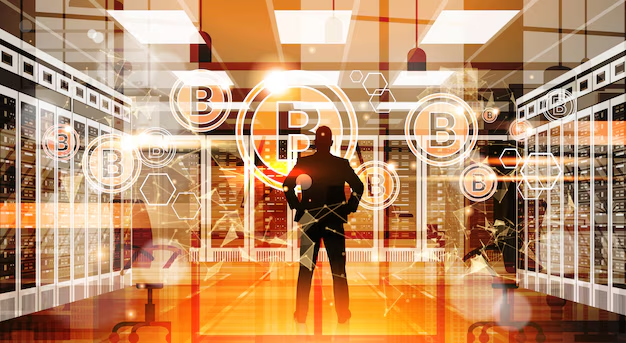Here’s an example:
Think of the delicate choreography of a global supply chain: container ships slicing through oceans of steel grey, trucks pounding no-wake along endless highways, warehouses humming with activity, a well-rehearsed rhythm of goods moving from the source to your home. As supply chain professionals, we dance to the rhythm of this machine every day, feeling the pressures of on-time delivery, and the invisible tension of possible disruption. Then came blockchain, the touted silver bullet, the solution for transparency, traceability and trust. It was meant to stitch a digital tapestry across this complex system, providing unprecedented visibility. We all saw the potential, the raw power of an immutable, decentralized ledger, and many of us, myself included, placed bets on its promise.
But what if — just what if — this shiny new technology has an Achilles’ heel? What if the real world—the real world of ports, production, packaging, all the things that can feed data into this manufactural marvel—one on which it’s supposed to build—is the thing that can be vulnerable to all this? I can recall all the meetings, all the whiteboards full of new ways to use this tech. We envisioned a world where inefficiencies would be eradicated and fraud exiled from existence. This is, of course, our very own, “what if we let the band all have too much to drink, and the show ends up not quite as good as we remember it,” kind of thing — the question we have to ask ourselves now, the question that plagues me at the very edges of my optimism, is this: “what happens when the infinitely scalable, digitally enabled dream-world lands in the real world, and the horrible, curly, in-bred evil at the very core of this new adamantly pro-censorship vision of us is indeed — just that — us?” It’s not an abstract problem anymore, it’s a pervading question mark, a potentially fatal single crack in the armor of the grand narrative of the blockchain. So, dear reader, here is the story I want us to dive into — the story of how the nature of supply chain’s inherent fragilities might be clue to blockchain’s eventual downfall. And it’s a story that, in itself, can help change the future of our industry.
The logistical hum of what was once a predictable symphony of forklifts and barcode scanners has been replaced by another kind of urgency. The Supply Chain Management (SCM) market is no longer just a sleepy back office function, it is also a real battlefield where fortunes are won and lost. Let’s dive in, shall we? Forget those static textbook diagrams; this is a living, breathing entity, molded by powerful currents.

Positive Trends: Winds of Opportunity
Digital Transformation: The Smart Supply Chain: Picture a scenario in which each element in the network, beginning with raw material and culminating in the consumer, flows through in a perfect connection. That’s the promise of digital transformation. We are talking about that kind of thing — AI-enabled demand forecasting that can predict consumer needs with unsettling accuracy.’ Sensors in warehouses that maximize storage and minimize spoilage. Using blockchain for ironclad traceability, combatting counterfeits; cryptocurrency for provenance assurance. Businesses such as Maersk, using IoT for real-time cargo tracking, are thriving and not merely surviving. They’re not just responding; they’re crafting the narrative.
- Impact: The organizations that embrace digital transformation become agile, visible, and competitive.
- Takeaway: Companies should chose to invest in digital infrastructure, have data analytics capabilities and adopt AI-driven solutions;
Sustainability: The Green Thread: The growl of the consumer is increasingly calling for a sustainable supply chain. Disclosure about sustainable sourcing, green packaging and carbon footprint mitigation are no longer nice-to-haves, they’re must-haves. Patagonia, like, built a whole brand around conscious consumption and ethical production, showing that sustainability could be a potent differentiator.
- Outcome: Improved customer loyalty, less waste, and potential savings.
- Actionable Insight: Address every link in your supply chain with sustainability. Aim to work with suppliers who are sensitive to the environment and have transparent manufacturing processes.
Against the Current: Navigating Adverse Trends
Geopolitical Unpredictability: Continual Changes: Trade wars, political tensions, and unpredictable world events (ahem, pandemic, anyone? are scrambling finely tuned supply chains, revealing vulnerabilities that were previously theoretical. Companies that depended on single-source suppliers burned in recent disruptions.
- Sales: Supply chain bottlenecks, higher costs and possible production shutdowns.
- Actionable Insight: Diversify your supply base, create contingency plans, and favor resilience over efficiency at all times.
Talent Gap: The Missing Piece: The swift pace of digitalization calls for a specialized talent—expert data scientists, cybersecurity specialists, and supply chain strategists who are familiar with cutting-edge technologies. That has created an unprecedented talent vacuum for these skills that is driving up salaries and affecting recruitment times.
- Impact: Challenges adopting emerging technologies, rising operational costs & bottlenecks in innovation.
- Take Action: Prioritize upskilling existing employees, partner with universities and training programs, and create compelling compensation packages.
The Story Unfolds:
The SCM landscape is more than just a marketplace; it is a living ecosystem continually redefined by the forces driving these trends. The companies that deftly navigate these waters—literally sailing the winds of opportunity while hunkering down against adverse storms—won’t just survive, they will thrive. To be static is to become obsolete, replaced by those who are not intimidated by change, but instead view it as a challenge, to innovate and promote agility. It’s a difficult landscape, to be sure, but also one full of opportunity for those with the foresight to spot it. And that’s the story we’re all telling at the moment.
- Healthcare Imagine a busy hospital, its hallways ringing with footsteps in a hurry. In the past, tracking critical medical supplies — a particular kind of surgical gloves, say — was akin to wading through a muddy swamp. None of it had expiration dates, and shortages became a recurring nightmare, with doctors scrambling. Now, with a blockchain-enabled supply chain, every box of gloves possesses its own digital identity, a fingerprint that tracks it from factory floor to operating room shelf. Just before surgery, a nurse scans a QR code, confirming that its authenticity, expiration date and storage conditions are correct, instantly. No more surprise shortages and, even better, the risk of using expired supplies is all but eliminated. It goes beyond efficiency, safety is a direct outcome of refined, open processes.
- Technology: Take the complicated process of making a smartphone. Components arrive from all corners of the earth — chips from Taiwan, glass from Japan, batteries from Korea. Classic supply chain was a maze, a black box wherein information disappears and delays are the new normal. Enter blockchain. At this point, each part is registered on a shared ledger that is accessible to all groups involved. Then a chip supplier in Taiwan discovers its shipment is stuck at customs. Notified in real time, they redirect it, avoiding slowdowns upstream. And this visibility, in turn, helps alleviate production bottlenecks and assembly time, enabling a faster reach to the impatient consumer when it comes to landing that next smartphone. Thanks to distributed ledger technology, the once murky waters of the supply chain are now clear as crystal.
- Autotrade: The autotrade faces the mother of all challenges with complex components and long global assembly lines. Take the manufacturing of an SUV. In the past, obtaining high-quality, conflict-free cobalt for electric car batteries was a perennial worry. The technology of blockchain provides a digital trail of the cobalt, from the mine to the car. From his desk, a manager can view the entire journey of the raw material. It can certify that it is ethically sourced on the blockchain. Now, the company can tell its consumers every car is a product of ethical, sustainable practices. Blockchain transcends mere logistics, positioning itself as a guardian of corporate virtue, where every journey is not just a physical mile, but a commitment to corporate nobility.
Part 1: The Need to Innovate
“I need you to help me get out ahead of this,” said Sarah, the VP of Logistics at a mid-sized manufacturing company, as she looked at a report indicating they were paying more for shipping. Her team, like so many others, felt the pressure. As a result, they started on an organic growth path along with Enhanced Data Analytics and AI Integration. They didn’t buy anything, but they put a lot of money in-house for training and new platforms to scrape real-time data from their then-ongoing blockchain network to predict demand swings using AI algorithms. It enabled them to adjust their production levels ahead of time and thus reduce the risk of surplus inventory or the expense of last-minute orders.
Middle: Investigating Synergies and Mergers
At TechSphere Inc (a top SCM solutions provider), the CEO Mark spoke about their inorganic growth strategy. “We need to broaden our base,” he told his strategy team. Such was the demand for the sustainability tracking solution that TechSphere purchased a small firm called GreenTrace, a company that only tracked carbon footprints using blockchain. Enabled TechSphere to get prebuilt modules and specialist talent through this Acquisition of Specialized tech which allowed for quicker implementation as well as a more complete choice which would take their in-house group time in the short term.
A rival in the space, Global Logistics Network (GLN), took a more familiar approach. They started Strategic Partnerships & Joint Ventures instead of outright acquisitions. GLN partnered in a joint venture with a collection of last-mile delivery startups utilizing blockchain verified fleet management that allowed both parties superior control over transit times and increased visibility on behalf of their shared network of customers.
A strong record in building a robust & resilient supply chain
The organic initiatives of companies like Sarah and the inorganic approach of TechSphere and GLN contributed to a supply chain ecosystem that was more resilient and responsive. Companies that had spent the decade building their own capabilities, strategically expanding, or created relationships, utilizing coming blockchain and other supporting tech, found themselves much better positioned to adapt to changes in the marketplace by late 2023 than their competitors. And with this transition, Sarah at her company no longer had to worry as much about fluctuating costs, while TechSphere and GLN remained at the cutting-edge of the evolving SCM tech landscape.

Outlook & Summary
This article is more than an exploration of a new niche in sustainable business; it’s a vision of a future in which the din of logistics sounds more like the music of a concurring harmonized network of information. That’s the utopian promise of blockchain in supply chain management, a vision shimmering with efficiency and transparency. But, as this post examined, shadows remain. The bedrock we’re building on — the physical, tangible supply chain — is fraught with inconsistencies, errors and good old-fashioned human fallibility. These are chinks in our digital armor.
In the next five to 10 years, we really will have a reckoning. There will not be a magical fix-all solution with the adoption of blockchain; it will be a mirror of the true state of our supply networks. We’ll watch as the technology is stretched, if not exposed, by the same age-old problems: mislabeled goods, delayed shipments and the chaotic waltz of data entry. This isn’t an indictment of blockchain itself, but rather a plea to recognize that it is only as advisable as the weakest link in the physical chain. The real revolution — if it does come — will depend on an unrelenting focus on precision, from the first harvest to the last delivery, in both the physical and digital worlds.
The key takeaway? The future of blockchain is inextricably intertwined with the operational realities of supply chain. It’s like putting a great new engine on a cart with wonky wheels — the engine is only going to perform as well as the cart it has as an appurtenance. Simply hoping for technology to fix all the ills won’t work. The true challenge is tuning into the elements of what good supply chain management looks like. But we cannot simply introduce blockchain; we need to you too refine and enhance the processes that blockchain intends to simplify. So as we look forward, are we really ready to tackle the causes of supply chain problems, or are we just slapping a sci-fi adhesive strip over a leaking system?





